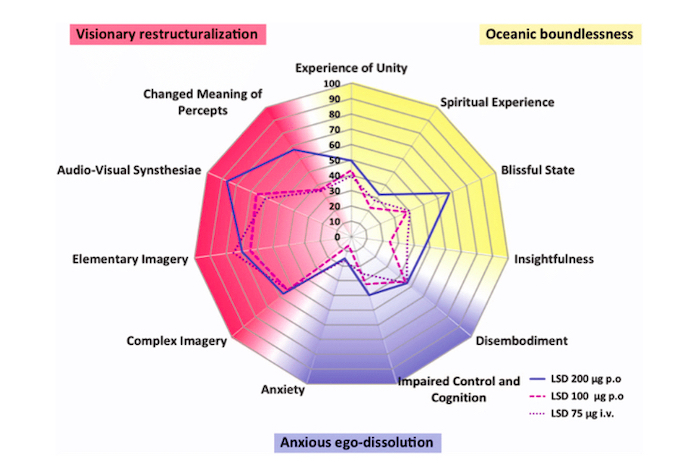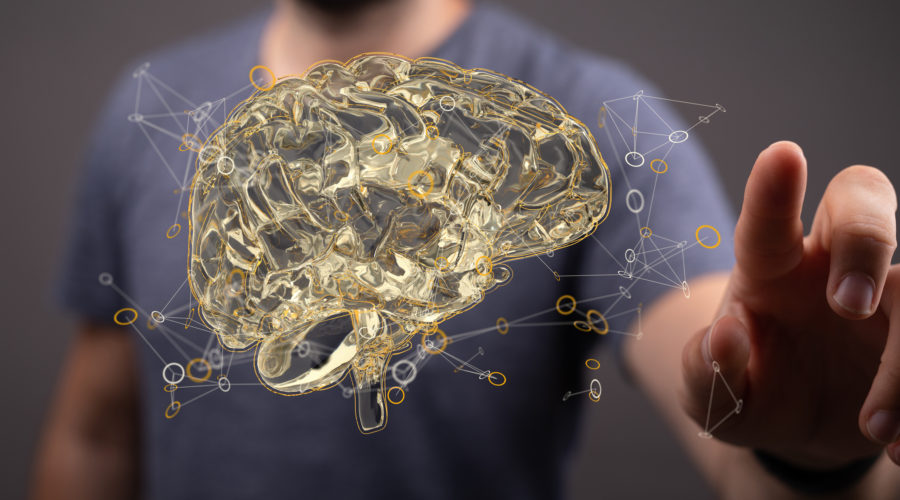Understanding The Five Dimensional Altered States Of Consciousness (5D-ASC)
No worries if you’ve arrived here on the sheer notion of how amazing the phrase ’five dimensional altered states of consciousness’ truly is.
When it comes to psychedelic neuroscience, we have some pretty interesting names for things — tachycardia is a fun one. Anxiolytic is another great word to drop, along with microiontophoresis. However, “Five Dimensional Altered States of Consciousness” (5D-ASC) is, undoubtedly, the most impressive thing to say at your next party.
The “Five Dimensional Altered States of Consciousness” (5D-ASC) is a scale used by scientists to quantify the qualitative subjective experience of psychedelics. It was created by A. Dittrich, and is a way to measure how intense a psychedelic trip is.
RELATED: The Top 10 Psychedelic Science Studies Of 2022
Understanding The Five Dimensional Altered States Of Consciousness (5D-ASC)
Although it has five-dimensional in the name, it’s actually an 11-dimensional scale, and occupies three genres or themes of psychedelic trips. Those three themes are:
- Visionary Restructuralization. This covers visuals experienced in trips
- Oceanic Boundlessness. Covers general blissful or otherworldly experiences in trips
- Anxious Ego-Dissolution. Essentially, this is physical dissociation or hyperfocus within a trip
Within those three themes are eleven dimensions:
- Experience of Unity
- Spiritual Experience
- Blissful State
- Insightfulness
- Disembodiment
- Impaired Control and Cognition
- Anxiety
- Complex Imagery
- Elementary Imagery
- Audio-Visual Synesthesia
- Changed Meanings of Percepts
In order to give measurement to it, these dimensions are accessed using a 0-100 scale. To obtain these measurements, a questionnaire is used that assess the various aspects of a psychedelic trip.
It includes things like:
- My sense of time and space was altered as if I was dreaming.
- I was scared without knowing exactly why.
- I could see images from my memory or imagination with extreme clarity.
Participants taking this questionnaire indicate their answer on a sliding scale, with a negative response on one end, and a positive response on the other end. Of course, there’s everything else in between.

Each of the 94 questions is categorized into one of the eleven dimensions of the 5D-ASC scale. The median of the scores are marked on the “Five Dimensional Altered States of Consciousness” (5D-ASC). Once the data points are marked, you just connect the points to make a really weird and oblong shape.
The 5D-ASC is given after a psychedelic experience, and, based on the amount of psychedelics used, it may yield some interesting results.
RELATED: Author Beth Bell’s Spiritual Experience With Psychedelics
What A Completed 5D-ASC Graph Looks Like
Below is a completed “Five Dimensional Altered States of Consciousness” (5D-ASC) graph. The data comes from three separate psychedelic studies of LSD with varying amounts.

Ideally, any person can accurately administer the 5D-ASC scale and record the extent of a person’s psychedelic trip. You can give it to your friend after a long-weekend at a festival — or if you’re into psychedelic therapy, you can incorporate this scale into your own practice.
The obvious hurdle is actually getting a blank “Five Dimensional Altered States of Consciousness” (5D-ASC) scale to administer along with the 94-questionnaire itself.
Well, today you’re in luck. In this article, we’ve included 5D-ASC templates in three versions.
The first is an empty scale on a white background. The second, the same scale, but with the classic color gradient to help distinguish the areas of the 5D-ASC. The third is a blank scale, but on a transparent background.
Of course, we’ve also included the original questionnaire from A. Dittrich as well.
Feel free to download these “Five Dimensional Altered States of Consciousness” (5D-ASC) scales and questionnaire. Above all else, share this page with your friends and colleagues so they can also have access to these scales.




Friedrich Binder
December 13, 2022 at 5:07 pmGreat Ressource, Zeus! Thanks for that. One question: In the questionnaire it is not indicated which set of questions corresponds to which if the four quadrants. Would be great if you could help me with this.
All the best
John Doe
January 18, 2023 at 3:53 am1 Experience of Unity 5D-ASC: 18, 34, 41, 42, 52
2 Spiritual Experience 5D-ASC: 9, 81, 94
3 Blissful State 5D-ASC: 12, 86, 91
4 Insightfulness 5D-ASC: 50, 69, 77
5 Disembodiment 5D-ASC: 26, 62, 63
6 Impaired Control and Cognition 5D-ASC: 8, 27, 38, 47, 64, 67, 78
7 Anxiety 5D-ASC: 32, 43, 44, 46, 56, 89
8 Complex Imagery 5D-ASC: 39, 79, 82
9 Elementary Imagery 5D-ASC: 14, 22, 33
10) Audio-Visual Synesthesiae 5D-ASC: 14, 22, 33
11) Changed Meaning of Percepts 5D-ASC: 14, 22, 33
Andrea
February 6, 2023 at 4:43 pmThanks, but the entry 10 and 11 are equal to the 9. Could you please update?
Frieder
November 17, 2023 at 8:24 amYou can find it in here
https://www.ncbi.nlm.nih.gov/pmc/articles/PMC2930851/
Friedrich Binder
March 8, 2023 at 8:00 amSaw this just now, thank you so much for your reply!!
MG
June 26, 2023 at 7:26 pmThank you for sharing this! It’s much appreciated; as someone with a background in academic research (though not in this field unfortunately), I’ve been looking for a useful way to document and interpret my own experiences over time. I’ve seen references to this scale before but couldnt find it. I appreciate it and the work you’re doing!
Anna
August 2, 2023 at 12:04 amThis is great, but I am wondering if you’ve also seen the 5d-asc expressed as a single percentage. In other words, can you use the single mean score for the entire measure? Is it validated in this way? I can see this approach being useful in clinics/healing centers where scoring these for clients would be an astronomical task. Thanks in advance for your input!